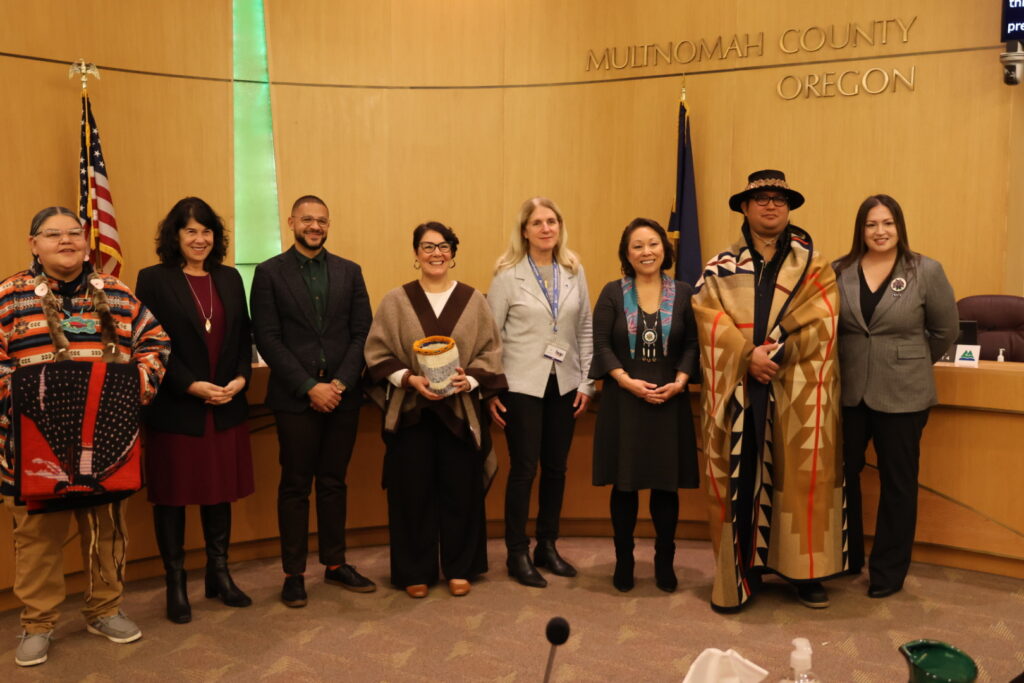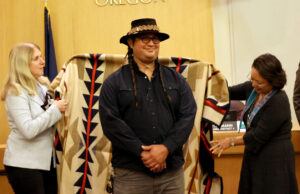
Members of the Multnomah County Commission and Bridge Renaming Council pose together following the commission’s decision to adopt the name of Wapato Bridge for the bridge to Sauvie Island. The Commission was gifted by the Columbia River Inter-Tribal Fish Commission with a wapas, a woven basket traditionally used by Columbia River Plateau tribes to gather roots and berries.
Photos by Jill-Marie Gavin, CRITFC Communications
by Jill-Marie Gavin, CRITFC Communications
PORTLAND – Renaming the Sauvie Island Bridge became an opportunity to celebrate and honor tribes and their connection to their First Foods, all while building stronger government-to-government relationships in the Portland area.
On November 30, the final day of Native American Heritage Month, the Multnomah County Commission unanimously voted to adopt “Wapato Bridge” as the new name of the bridge connecting Sauvie Island to the mainland. Wapato, an edible plant used by the region’s Indigenous peoples, was once abundant in the wetlands that surround the island.
Friday’s vote was the culmination of a year-long process that was led by the Bridge Renaming Council (Council). The Council was comprised of tribal representatives and community stakeholders. The vote occurred exactly a year after the Multnomah County Board of Commissioners embraced the initiative to rename the bridge, acknowledging the Native American communities that had historically been located there and the continued significance of the island to present-day Native peoples.
In November of 2022, Multnomah County Board of Commissioners voted to establish the Council, specifically including tribal representatives from various tribes historically linked to the island. By doing so, they kicked off an initiative that has marked the county’s inaugural formal consultation process working with tribal governments, engaging appointed cultural guardians, revered elders, tribal representatives, and administrative staff in the decision-making process. Corinne Sams, CRITFC Chair, was appointed to represent the Confederated Tribes of the Umatilla Indian Reservation representative on the Council. Sams is an elected member of Umatilla’s governing body, the Board of Trustees.
During the summer of 2023, the Council reviewed proposed names sourced from tribal government representatives, island inhabitants, online feedback, and outreach efforts. Following their decision-making criteria and considering the input from diverse communities, the Council recommended the name “Wapato Bridge.”

Wapato Bridge, formally known as the Sauvie Island Bridge
During the Nov. 30 commission meeting when the name was formally adopted, Multnomah County Tribal Affairs Advisor Anna Allen gave a thorough report on the Council’s process and use of “Indigenous Placekeeping.” Indigenous Placekeeping is a process that includes the pillars of Traditional Resource and Land Use, Original Villages and Languages, and Tribal Elder and Community Voices.
In the Council’s research for historical use of the island, they learned that the original name of the island was connected to Lewis and Clark’s observations of tribal people gathering wapato, a traditional First Food, there. In their diaries, Lewis and Clark referred to it as “Wapato Island” due to the abundance of the root, which they described as an “Indian potato.”

County commissioners gift council member Lukas Angus with a Pendleton blanket. From left are Commissioner Julia Brim-Edwards, Angus and Commission Chair Jessica Vega Pederson.
Lucas Angus (Nez Perce) was applauded by both Council members and county commissioners for prompting the process. Though he described himself as “distrusting of government” while delivering testimony, he said he was overall grateful to have been a part of the process. County Commissioners took time to individually describe their gratitude for being voters on the historic decision.
At the end of Allen’s presentation Council members gave their final comments. Chair Sams reminded the commission that along with Oregon tribes’ traditional use of the area, it was important to remember the Washington and Idaho tribes, such as the Yakama Nation and Nez Perce Tribe, that fished, hunted, and gathered there as well. She also spoke about the traditional order in which First Foods are served which shows the significance of the connection tribal cultures have to food and land, with wapato being included in that group.

Wapato is known as the “Indian Potato” and is a First Food of the Indigenous people who were the original inhabitants of Sauvie Island.
“It is our life’s work to echo the words of our ancestors, not only for us today but for those who are yet unborn. The significance of this project and work is tremendous, not only for me, but for those came before me and those will come after,” Sams said of the Council’s work.
Multnomah County Commissioner Lori Stegmann delivered her statements of gratitude during the commissioner’s question period following Allen’s presentation and hearing Council member and public testimony.
“I love learning about [wapato] not just being a food; food is incredibly important, but it’s a medicine. All of our lives are so ingrained in ceremony. Hearing and learning more about Indigenous ceremony, placemaking, and Indigenous foods, the connection to food and water and earth. It makes our community so much better and makes us such better caretakers of ourselves and each other,” Stegman said.
Commissioner Sharon Meieran said one of her favorite processes during the year was watching metaphorical bridges being built during the renaming of a physical bridge. She thanked Angus for joining the Bridge Council despite his suspicions because she was grateful for the meaningful work he contributed to and education he provided.

Chair Vega Pederson embraces CRITFC Chair Sams after receiving a wapas. The wapas is a traditional woven basket used by Columbia River Plateau Tribal members to gather roots and berries.
County Chair Jessica Vega Pederson thanked the Council for the opportunity to work with tribes on governmental matters.
“I want to echo the thanks and gratitude for this opportunity. It’s really an opportunity for us to step into a partnership and work. Like we heard in an item earlier today, letting community lead, letting our partners in all the different communities, the tribal communities and nations lead, really leads us in the work that we need to be doing as a government body,” Vega Pederson said.
Shana McConville-Radford, newly hired as Governor Tina Kotek’s Tribal Affairs Director, said the project was a testament to how meaningful change can happen when local, state and federal governments conduct true consultation with tribes and tribal communities.
Each Council member and commissioner expressed their gratitude to Allen for her work in collaboration and leadership during the process.
“Anna Allen, Tribal Affairs Advisor for Multnomah County, excelled in reaching out to all nine tribes interested in participating. This effort demonstrates the county’s commitment to prioritizing Indigenous peoples and their essential First Foods statewide. Emphasizing access to these foods and our rights to gather them in the metro area becomes a priority. This action sets a precedent for Portland-area entities to inclusively recognize more tribes and their historical significance in the region,” Sams said of Allen.

CRITFC Chair Corinne Sams shares a heartfelt embrace with Multnomah County Commissioner Lori Steggman after their vote rename the bridge to Sauvie Island the “Wapato Bridge” Nov. 30.
With the vote now final, the process to create new signage for the bridge and develop a plan for ceremonial unveiling of the newly-named Wapato Bridge is estimated to take around two months. The Multnomah County Commission office will release more information about plans to commemorate their decision as plans are finalized. To view the educational video on the Council’s work visit here Renaming Sauvie Island Bridge to Honor Native American People.



